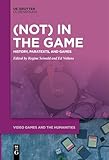(Not) In the Game : History, Paratexts, and Games / ed. by Regina Seiwald, Edwin Vollans.
Material type: TextSeries: Video Games and the Humanities ; 13Publisher: München ; Wien : De Gruyter Oldenbourg, [2023]Copyright date: ©2023Description: 1 online resource (VI, 224 p.)Content type:
TextSeries: Video Games and the Humanities ; 13Publisher: München ; Wien : De Gruyter Oldenbourg, [2023]Copyright date: ©2023Description: 1 online resource (VI, 224 p.)Content type: - 9783110737691
- 9783110732993
- 9783110732924
- 794.809 23/eng/20230823
- GV1469.34.H57 N68 2023
- online - DeGruyter
- Issued also in print.
| Item type | Current library | Call number | URL | Status | Notes | Barcode | |
|---|---|---|---|---|---|---|---|
 eBook
eBook
|
Biblioteca "Angelicum" Pont. Univ. S.Tommaso d'Aquino Nuvola online | online - DeGruyter (Browse shelf(Opens below)) | Online access | Not for loan (Accesso limitato) | Accesso per gli utenti autorizzati / Access for authorized users | (dgr)9783110732924 |
Frontmatter -- Contents -- Introduction: Video games as networked texts -- Section 1: Games and paratexts – a theoretical approach -- De-centralising the text: The text–paratext relationship of video games -- Paratexts, “authenticity,” and the margins of digital (game) history -- Section 2: History as game paratext and games as historical paratexts -- Account, accuracy, and authenticity: A framework for analysing historical narrative in games -- The past as (para)text – relating histories of game experience to games as texts -- Section 3: Game reception and paratexts -- Histories of Hearts of Iron IV: Understanding the past(s) through HOI4 Wiki -- Video game fanvids as paratexts and as texts -- Section 4: Game production and paratexts -- Video games with footnotes: Understanding in-game developer commentary -- Artefact, advert, or advertising? Getting to grips with game trailers -- Making sense of gameswork: University marketing materials as games paratexts -- Section 5: Paratextual practices of play -- “On a scale of 1–5, what floor are you on?” Practising methodologies of fun and play with transformative communities -- Conclusion -- Glossary -- Author information
restricted access online access with authorization star
http://purl.org/coar/access_right/c_16ec
How do games represent history, and how do we make sense of the history of games? The industry regularly uses history to sell products, while processes of creation and of promotion leave behind markers of a game’s history. The access to this history is often granted by so-called paratexts, which are accompanying elements orbiting texts. Exploring this fully, case studies in this work move the focus of debate from the games themselves to wider, ancillary materials and ask how history is used in, and how we can use history to study games.
Issued also in print.
Mode of access: Internet via World Wide Web.
In English.
Description based on online resource; title from PDF title page (publisher's Web site, viewed 06. Mrz 2024)


